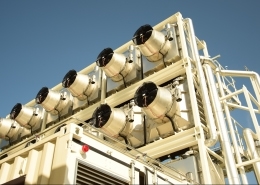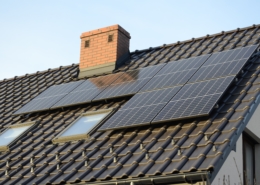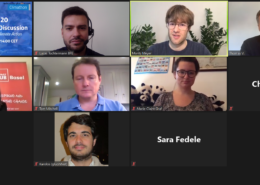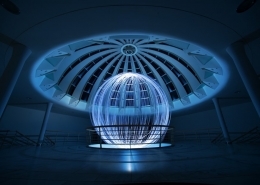Cold heads at Swisscom
Since 2019, Swisscom has been continuously replacing the cooling systems of its mobile phone base stations, thereby saving energy, time and costs. This project has resulted in a sophisticated innovation in the sector.
Whether you're on the top of the mountains on your weekend hikes or on the train to work: more than 5,000 mobile phone base stations provide reception via the Swisscom mobile network wherever you are. The antennas, which are installed on pylons or high buildings, communicate with each other and thus cover the best network in Switzerland. These mobile phone base stations are currently the subject of a major energy-saving project by Swisscom.
Less heat and more efficient cooling
A few years ago, Swisscom introduced a new antenna system that requires considerably less cooling than its predecessor. Thus, part of the antenna rake equipment is mounted on a mast on the outside of the building. Currently, the systems used for cooling the technical rooms are extremely powerful and energy-intensive. In 2019, Swisscom therefore began to replace these cooling systems with modern and sustainable alternatives.
The starting situation was a varied portfolio of split units (air conditioning systems) and cooling units: more than 300 different types of systems are currently in use. In the coming years, these will be replaced by only five different units, three of which have ventilation technology and two of which are suitable for cooling production.
Swisscom's current project focuses on the most energy-intensive cooling systems or those that have been in use for more than eight years. As a result, 1,250 sites have been defined, where the cooling units and split units will be replaced by the new systems. In this respect, ventilation is used as much as possible. The systems operate without compressors or coolant, making them both environmentally friendly and economical. The aim is to cool 70% of the sites with ventilation. If this is not possible for construction reasons, split units operating with the new R32 coolant will be installed. Implementation is currently in full swing: the systems have already been replaced at a quarter of the sites.
A dual economy
The project is bearing fruit: the new antenna system with its ventilation and cooling systems is enabling Swisscom to make significant energy and cost savings. Savings of up to 90% can be made on electricity costs when the ventilation is used, thanks to the lower requirements of the new antenna system and the more efficient cooling method. With good planning and a large savings potential, it should break even after only four years of operation. In addition, the Swiss Federal Office of Energy is supporting 30 percent of the project costs with the ProKilowatt grant programme.
A new kind of remote control: the Infrabox
In addition to the replacement of the cooling and ventilation systems, the project has resulted in a sophisticated innovation: the Infrabox. The IoT instrument enables Swisscom to control the cooling systems remotely and to measure electrical and meteorological data in real time. This creation is a novelty in the mobile telephony sector. We interviewed the developer and project manager Christian Rüttimann, who is responsible for the operation of the mobile phone sites.Christian Rüttimann, how did the idea for the Infrabox come about?
The efforts and costs required for repair and maintenance work are relatively high today. Often a specialist has to go on site first to identify the problem. The repair is done in a second step and requires the displacement of a new person. Now this process is much simpler: the Infrabox allows us to remotely control all relevant operating parameters, automatically or punctually, which makes repair and maintenance work more efficient.What are the advantages of the Infrabox in addition to saving maintenance and repair costs?
It ideally complements new cooling systems in terms of energy and cost savings. Sustainability is an important factor in this project. The measured values of the Infrabox are very useful for the energy optimisation of new cooling systems. So far, we have even been able to save more energy than was originally calculated. We wouldn't know this without the Infrabox. It is therefore also an important factor for the energy efficiency of new cooling and ventilation systems. Over time, it will provide us with a lot of important data on power consumption and climate.Wasn't such a device already on the market?
Conventional devices are limited to measurement and are very expensive. We want to actively control our ventilation and cooling devices remotely and to consult detailed energy consumption values in real time. This is why we have embarked on our own development.Isn't own development less effective?
No, on the contrary! As we are both customers and manufacturers, we can determine the individual functions of the device with great precision. When a manufacturer puts a device like this on the market solely as a producer, his aim is to cover as many needs of as many potential customers as possible. This approach makes the development more complex and the final product more expensive. As a telecommunications company, we are closer to the relevant networks and systems. We have thus taken the step from measuring alone to active remote control: the Infrabox operates on the fibre-optic network, which enables the fast transport of large amounts of data. In addition, we worked closely with the service technicians in the field. They replace the cooling systems and will maintain and repair them in the future. They are therefore in the best position to determine the various functions of the Infrabox.Who else was involved in the development?
We at Swisscom are fortunate to have specialist knowledge in many areas. I have therefore talked to specialists in business development or sustainability and taken their needs into account.How did you coordinate these different stakeholders in the process?
The solution has broad support within the company and involves many areas. However, I did most of the development. No project team was formed specifically to develop the Infrabox as part of a large-scale operation. The process was more like a do-it-yourself in the home workshop. However, what may seem like amateurism had many advantages. For example, I was able to bring together the knowledge of the technical experts on a very ad hoc basis, thus minimizing the coordination effort. This helped me to keep a cool head and stay focused on the essentials. This is what made this highly effective development possible in the first place.What do you mean by "extremely effective"?
It took barely eight months from the first idea to the beginning of the pilot phase. Today, around 3,000 units have been ordered and will be installed until the end of 2021. The Infrabox is great because of its simplicity. It is so simple that we will be able to use it in other areas. It is compatible with all major manufacturers and can be expanded with an unlimited number of ports. With the invention of the Infrabox we have only laid the foundation. The future will tell us what further developments we will be able to make in the future. In principle, fantasy knows no limits.Can you name a few examples?
Of course, we are still in our infancy. I can imagine areas of application extending to private households, for example in the style of smart home offerings. However, the next steps will first of all be to extend the offer to other areas of Swisscom. Other network operators have also already expressed interest in the Infrabox.
 Swisscom
Swisscom
 «Wir müssen alle Möglichkeiten ausschöpfen»
«Wir müssen alle Möglichkeiten ausschöpfen»  shutterstockWas können Optimizer bei PV-Anlagen wirklich leisten?
shutterstockWas können Optimizer bei PV-Anlagen wirklich leisten?  BFEClimathon 2020: Innovative Lösungen für den Klimaschutz
BFEClimathon 2020: Innovative Lösungen für den Klimaschutz  Universität St.GallenStromtagung-Special: Wie geht es für die Strombranche nach den eidgenössischen Wahlen weiter?
Universität St.GallenStromtagung-Special: Wie geht es für die Strombranche nach den eidgenössischen Wahlen weiter? 
 ©Béatrice Devènes
©Béatrice Devènes Parlamentsdienste 3003 Bern
Parlamentsdienste 3003 Bern
Dein Kommentar
An Diskussion beteiligen?Hinterlassen Sie uns Ihren Kommentar!